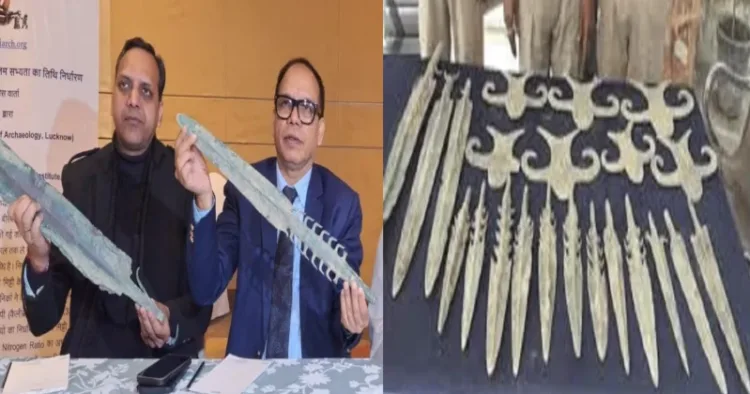The Archaeological Survey of India (ASI) has unearthed a significant cache of Copper Age weapons in Baghpat district, Uttar Pradesh. The discovery, which includes human figures and a range of weapons such as four-foot-long swords, axes, knives, maces, and arrowheads, is a testament to the advanced metallurgical skills of people who lived more than 4500 years ago.
The artefacts, all made from copper, were found in a location that offers new insights into the era known for the dawn of metalworking in the Indian subcontinent. These weapons believed to have been used for defence and offence, provide a glimpse into the tools that may have shaped the martial traditions of early civilisations.
The discovery includes four-foot-long copper swords, a rarity in ancient weaponry, and other weapons such as axes, knives, maces, and arrowheads, all crafted from copper—a metal that marked the transition from the Stone Age to the more advanced Copper Age. It is believed that these weapons were used in combat and daily life, making the find all the more significant in understanding the culture and warfare of the time.
Dr Amit Rai Jain, Director of the Shahjad Rai Research Institute, played a pivotal role in confirming the age and authenticity of these findings. The discovery’s timeline was established through radiocarbon dating, a process that accurately assesses the age of ancient materials. Dr Jain and a team of senior scientists from the Birbal Sahni Institute of Paleobotany in Lucknow worked closely with Vijay Kumar, former Director General of Police of Uttar Pradesh, whose efforts were instrumental in initiating the research project. Together, their work has provided critical insights into the age of the Copper Age Civilisation of India.
In total, 38 samples of the Copper Age weapons, initially stored at the Shahjad Rai Research Institute, were sent to Budapest, Hungary, for carbon dating. The samples were tested in a renowned laboratory specialising in dating ancient artefacts. After extensive analysis, it was confirmed that 35 out of the 38 samples were over 4500 years old, dating them firmly to the Copper Age, and adding a crucial layer to the study of ancient Indian civilisation.
The age of the weapons places them in the period preceding the events described in the Mahabharata, India’s ancient epic. While this period is traditionally considered part of the Bronze Age in many parts of the world, the findings in Uttar Pradesh offer concrete evidence of the extensive use of copper in ancient Indian warfare and tool-making practices. This finding is also noteworthy for its potential connection to the Mahabharata period, with some scholars suggesting that these ancient weapons might have been part of the same cultural context described in the epic.
Dr Jain emphasised that these weapons are among the oldest metal artefacts ever found in India. “The Copper Age weapons of India are the most ancient metal weapons discovered so far. These findings not only shed light on the advancement of metallurgy but also highlight the complex social and technological developments of early Indian civilisations,” he stated. The importance of this discovery lies not only in the age of the weapons but also in the metallurgical skills demonstrated by the people of that time.
In addition to the findings in Baghpat, ongoing research at the Shahjad Rai Research Institute is focused on a separate collection of about 225 Copper Age weapons discovered in Nigohi, Shahjahanpur. The institute’s researchers are collaborating with the History Department of Chaudhary Charan Singh University to further study and contextualise these artefacts, ensuring their historical significance is fully understood.
The discovery of these ancient weapons offers valuable insights into the technological advances of the Copper Age people and their role in shaping early Indian history. As research continues, the findings have the potential to redefine the history of metalworking in India and provide a deeper understanding of ancient Indian warfare. With such groundbreaking discoveries on the horizon, the story of ancient India’s rich heritage continues to unfold, offering a fascinating glimpse into a civilisation long before recorded history.



















Comments